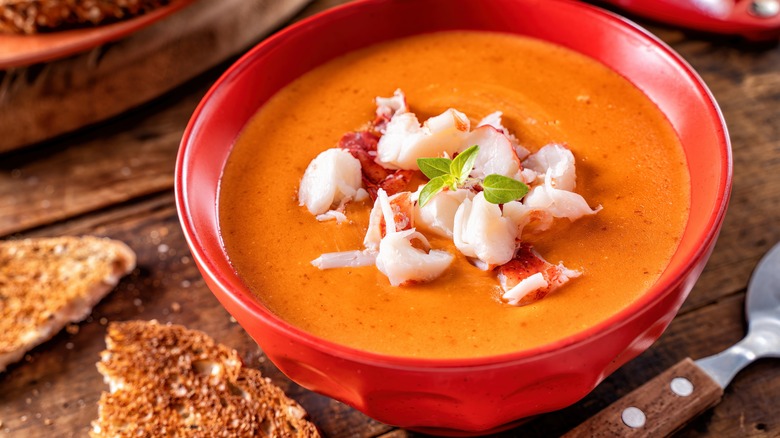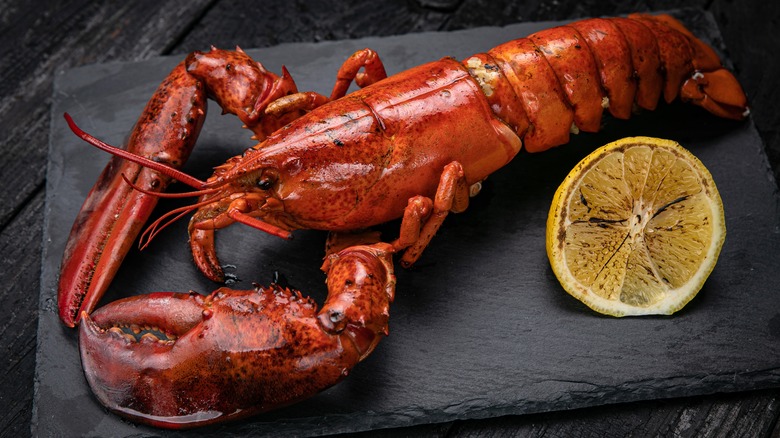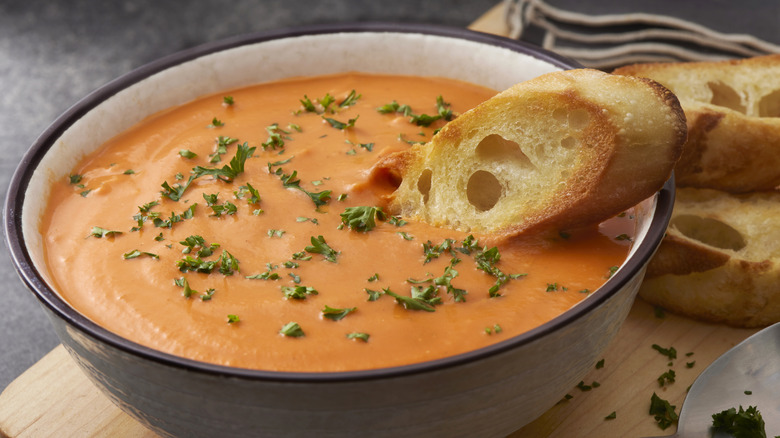Lobster Shells Are The Key To Restaurant-Worthy Bisque
Close your eyes and take a deep breath. The brackish air and sea breeze brush your cheeks, the buoys are dinging, the lobster cages rattle as they hit the dock, and the waves lap at the rocky shore. A good lobster bisque can transport you right to a Maine seashore — and the key to making one that does is all in the shells.
One of the main differences between standard home cooking and restaurant cooking (beyond very generous usage of salt and butter) is the way flavor is layered. To make a truly excellent lobster bisque, start with a seriously flavorful lobster stock. That means prepping your lobster shells to release the most flavor as the stock simmers.
If you've had a lobster dinner and retained the shells, that's a good shortcut to prepping lobster stock. If you're working with fresh lobsters, a quick five-minute parboil will help sever the meat from the shells. This will let you work with the shells without overcooking the meat — the next steps involve high heat, a longer boil, and maybe even grinding down the shells. It's a bit of work, but it's worth it for a restaurant-worthy Maine lobster bisque that will make you feel like you're on a patio on a crisp day in Cape Elizabeth without ever leaving your kitchen.
Cook your lobster shells well, first
Making lobster bisque starts like making any other great soup: With the stock. If you've made chicken or beef stock, you know that it begins with bones. The minerals, proteins, and collagen in bones flavor the water as it simmers for a long time. But, as you likely know, lobsters don't have bones — they have shells.
The shell of a lobster is made up of proteins, calcium, carotenoids, and other trace minerals. The minerals and proteins flavor lobster stock and the carotenoids give it color. Shells are also made up of a lot of chitin — this is what the shells of lobsters, crabs, and shrimp are made of, but it's also found in other arthropods (like crickets). It's made of an amino sugar, which, at high heat, will combine with the protein in the shells to create our favorite browning effect: The Maillard reaction. Like roasting chicken or beef bones, browning lobster shells for the stock is the key to a complex, flavorful stock for lobster bisque. This can be done in two ways: By sauteeing them in a hot pan or roasting them.
The other thing chitin does — and one of its main industrial uses — is thicken food. Like collagen thickens bone broth, chitin can thicken your lobster bisque. You just need to access it.
Do you need to grind the shells?
As an exoskeleton, lobster shells are durable. You need to crush them to access the chitin and thicken the soup. The old, "proper" way to make lobster bisque included grinding down the shells with a mortar and pestle. This method is very labor-intensive and, truthfully, may not be worth the effort. You may be tempted to use a blender or food processor, but lobster shells are so hard that using the blades in your machine to grind them down will just dull your blades.
Instead of grinding, try smashing. The lobster stock will be plenty flavorful with these broken, smashed shells without powder-grinding them. You can use a meat pounder, a potato masher, a rolling pin, or a hammer to accomplish this. Once your bisque is cooked, strain the shell pieces before enjoying it. As for thickening the bisque, use your favorite thickening method: A roux, cornstarch, rice flour, or whatever floats your lobster boat.


